Don't wanna be here? Send us removal request.
Text
I find the way that the world always looks upright regardless of how I turn my head fascinating. I decided to create a photographic series to express that feeling, so I stood in place and took photos, turning the camera with my head to change the horizon line. I collated the photos and aligned them on a wall to create a consistent eye line, expressing the differences in perception.
This piece ties back into my early creations this semester, looking in an almost childish way at the scientific causes behind features of life that we frequently take for granted.

I like this piece overall, though in future I would like to experiment with ways to add annotations or similar, exploring the reasons that this actually happens. That said, I didn't want to make this a conceptual copy-paste of my skipping stone work.
0 notes
Text
I was putting my collection of random unconnected hands away, and I put them in a jar. I really liked that look, and I was finally inspired to do something with them. I wanted to iterate on my gore drawing, and paint each hand into different internal organs.
This also conceptually ties back to my hand body artwork A Body. It explores a different facet of the idea of trying to force yourself to fill a function that doesn't really fit your skills or desires. I'm calling this piece Wanna Be. It shows hands that are trying to appear as internal organs, which they just... aren't. It speaks to the way that people can be forced into boxes and made to try to become and identify as things that they're not solely because of people's expectations.
A hand can't be an eye or a lung or a large intestine, so why not allow it to thrive and be the hand that it is? What happens if the world rejects all of one person? Who's left to fill in their place.


0 notes
Text
I was researching the abject art movement, and I again encountered Doreen Garner's work. I had seen some of her pieces in passing, but I had never properly investigated the artist, so it was interesting to go back in and research her work and motives for myself. I find the way that she forces people to view her work through the incredible detail she includes, while making them appear almost repulsive. I think this ties into my practice quite well. Garner creates art as a form of activism for black women, protesting against oppressors, while also making an effort to highlight and bring awareness to the atrocities of the past, allowing her work to declare that the past will no longer go unseen.

Doreen Garner, Rack of Those Ravaged and Unconsenting (detail), 2017, silicone, foam, glass beads, fiberglass, insulation, steel meat hooks, steel pins, pearls, 96 x 96 x 96″.
Image Source: https://www.artforum.com/events/doreen-garner-and-kenya-robinson-238364/
Another artist I found interesting was Andrej Zunka. His works are fascinating as they create a shift from the expected reality. One series that I found striking was The Fleur, which digitally manipulated real flower species to overstate the small features which make them unique. He created really fascinating concepts, and it's amazing to realise that the concepts very nearly exist in nature already. It highlights the beauty of biodiversity, and highlights what we stand to lose should we allow these species to die out.


Connexa Chamaemilla (Left) and "The Tulipa Nodatus" (Right), Digital Images, Andrej Zunka (2022)
Image Source: https://thursd.com/articles/ondrej-zunka-explores-human-dependency-on-plant-species-through-digital-botanicals
0 notes
Text
I find it frustrating and exhausting to have my life constantly categorised as one thing or another based on a single fact that people know about me. They assume that every part of me is fully reliant on their stereotypes, whether those be that I am a woman, a Christian, an artist, a leader... I'm sick of fighting for control of the purpose of my own life.
I made this artwork to express that frustration. It says what it means quite explicitly, yet I'm sure that many people who see it won't actually act on it. I initially wasn't sure how to display this piece, but I was thinking about the tension involved, and was reminded of how my embroidery work The Seeds of Hope uses thread to create that tension, so I decided to try incorporating thread into my piece. I like the result. I think I would have liked to make this bigger, or potentially add more body parts into the mix with their own takes on the concept. This may be a mode for future experimentation.

The words included read as follows:
"This is 100% a hand. This is 100% me. It's not 100% of all the hands in the world, that would be preposterous. It's not 100% of me either. It is a momentary glimpse at the slightest fraction of my physical form, so while it is entirely made of well... me, it is by no means the extent of my identity. I am made up of so many 100%s that the number becomes virtually meaningless. At the end of the day, the only 100% which can hope to define me is that I am 100% me. Let my actions fill out the rest for you. There aren’t enough little labels in the world to define every little percentage that makes up me, so please stop trying to reduce me down to fit the little labels that you’ve decided make ‘me’ up."
0 notes
Text
After my skin was mostly healed, I wanted to experiment with other ways to preserve impressions of my embroidery piece. When I removed the thread from my skin, I preserved the major pieces and kept them until my hand had healed over. I then experimented with other ways to create documentation of the embroidery using these pieces. I initially thought about placing them on my hand and making hand prints with them, but unfortunately the threads were too absorbent, and the prints were unclear.

After this, I experimented with making impressions of the pieces in clay. I quite like this one. It relates to traditional ideas of pottery where things are created to preserve stories and practices. It almost acts as a way to immortalise the impressions of the threads, even as the threads break apart in the process. I think this stands alone as its own piece at this point. It's definitely reliant on The Seeds of Hope, but it has a story of its own to tell now.

0 notes
Text
I saw an article about the artwork 'Digital Grotesque II' by Michael Hansmeyer. I found the vivid detail and texture behind this artwork to be highly compelling. It is a powder print which gives a very solid, rough texture reminiscent of stone and connecting it to traditional architecture. I also found it conceptually interesting. The article states that this artwork is generated digitally. I find this relevant because of the discussions happening about the role of AI in art. The artist also draws parallels between this artwork and imagination, which I think is really interesting. How much of art is imagination, and how much of art is physical? This artwork relies on the artist's concept and input (the imagination), yet it relies on technology to design and output the artwork. This artwork is making commentary on the human body and the import of human action through its apparent complete absence of human labour. I find this speaks to a similar concept to my Pebble artwork from the start of the semester, though in a very different way as it explores a digital realm, while my artwork is focussing on natural influences.

Image source and article: https://www.michael-hansmeyer.com/digital-grotesque-II
0 notes
Text
I find that walking around with the marks left behind by my embroidery artwork is a performance work of itself.
As people around me notice the marks, their first interaction is generally one of concern, before they notice that they follow a shape. Telling people what I did to make the artwork and in the process these scars makes people simultaneously horrified and fascinated. I think this duality is facilitated by the passivity of the artwork. Looking at my hand, even with the marks on it, it exists in a third person to viewers, and they have that built detachment. It makes the artwork more about the fascination and the horrifying idea of the artwork than about a visceral personal reaction to what is at its core body horror. I like that this work can make people connect the concept of causing pain to create beauty and surrounding concepts without actually understanding the specific feeling of the pain.
The below images track the scarring over three days after I embroidered my hand.



0 notes
Text
I finally managed to make a something I have been intending to make for quite a while now. Inspired by my own artwork where I painted on my hand, as well as by Nicoletta De La Brown's work embroidering the unconventional surface of a plastic bag, and I wanted to embroider the skin of my hand. I did initially experiment with using PVA and liquid latex to cover my skin and use as a proxy, but I found that they lifted from my skin when pierced and left little air bubbles, or they were so thin that the needle went through my skin anyway, and they tore through. The only other thing that was stopping me was that I had a healing scar on my hand. I knew that this artwork would cause new injuries in a way, and I didn't want old injuries to interfere with the effect.
The inspiration for my design was initially inspired by a passage stating that suffering can grow perseverance, which in turn develops character, which finally helps to produce hope in hardship. I decided to design the artwork with flowers known to symbolise hope and strength of character (magnolia, plum blossom, gladiolus) in response to this inspiration. This sketch is my concept design.

In experimenting, I discovered that one shade of purple paint that I own stains skin lightly after being washed off enough that it was visible, but faint enough that it didn't show up on camera, so I used it to sketch out a base for my design on my hand to follow. (The photo below is from while I was working on the sketch before the paint was washed off).

I decided to record the whole process, but my SD card ran out of space half way through, so I lost a good deal of the footage. I hope to experiment with editing the footage to create some form of result later on.
This is the final embroidery piece.


I like that the string created a sense of tension and restriction as it limited the movement of my hand. Reading this artwork outside of my initial inspiration, I find that it draws on the conceptual links of embroidery both to the craft movement and to feminist art. The way that it restrains the hand, as well as the literal physical pain that the hand was put through in order to create this work speaks to the way that female creators and artists are often held back in their endeavours by societal expectations of womanhood. It does also reflect of the dangers that women can face from the men in their lives, though as I have not personally experienced a high degree of physical abuse or similar in my own life, I am only comfortable seeing this as an expression of solidarity, not a statement of personal experience.
1 note
·
View note
Text
I was given a hand me down faux leather jacket, but it was deteriorating and unwearable, so I went through and cut out the metal pieces and zips that I could repurpose, and prepared the remainder of the jacket to be disposed of. As I was though, I became overly aware of the fact that I had labeled this thing as having nothing left of value in it. I saw parallels with this and consumerist cultures, as well as with the ways that it becomes easy for people to discard others once they've taken things from them, and see relationships as transactional. I went out and found a public place to display the apparently worthless remains of the jacket and photograph it (unfortunately I couldn't leave it there for very long because I didn't want to risk having it shed microplastics into the area).


I also photographed the remaining pieces - the only things left of value as a complement.

I've also experimented more with clothes, as I volunteer at an op shop. One of the potentially confronting aspects of working in an op shop is that we fairly often receive the remnants of deceased estates, and those often show glimpses into the story of a person's life, and the parts of their life that their family and friends deemed unnecessary to carry on. I photographed just a few pieces of clothing from a deceased estate, and edited them to look almost ethereal, turning the clothes into a memorial for the parts of a person that get left behind and sent away after they pass.

0 notes
Text
There are a number of different contemporary artists that I have been interested during this semester, but that haven't directly linked to artworks I was creating.
A number of them relate to abject art movements. One of these is works by Tung Ming-Chin. This artwork really effectively connects figures of the body and the supple forms of human interaction with the hard nature of wood, and the level of labour needed to develop such perfectly smooth timber forms.
The Birth of a New Hero (2008), 35x30x45cm (Left). Inner Turmoil (2009), 85x85x30cm (Right). https://www.thisiscolossal.com/2019/05/wood-sculptures-by-tung-ming-chin/
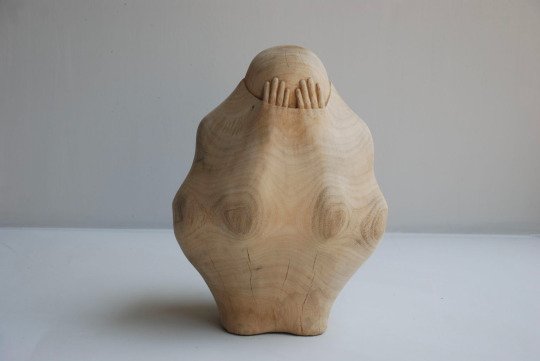
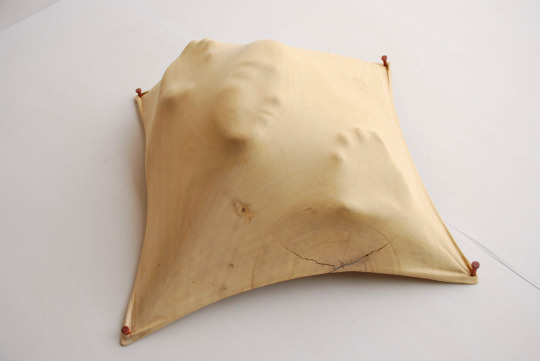
Another artist who creates visibly similar artworks is Lois Cecchini. Cecchini creates artworks depicting objects almost languidly being contained in a stretching wall. It creates a similar sense of tension to Ming-Chin's work, but with much more sterile forms and a more architectural focus, as if a world was being absorbed and forced into sterility.
http://inspirationist.net/extruding-bodies-by-loris-cecchini/
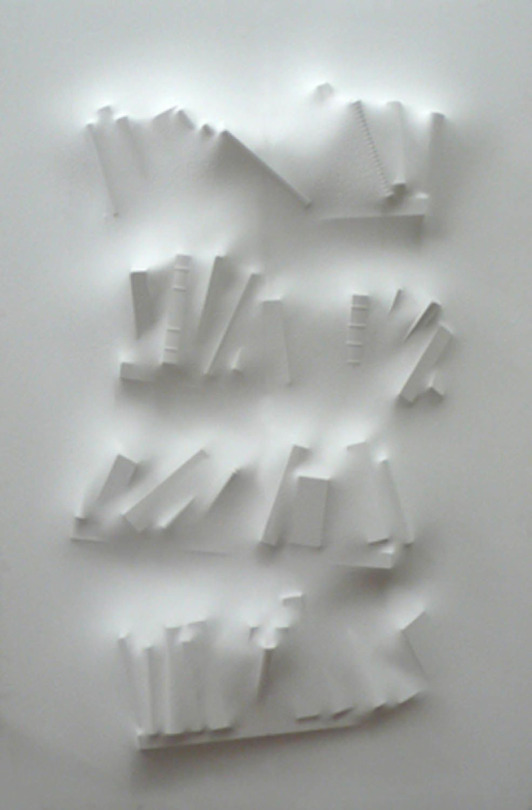
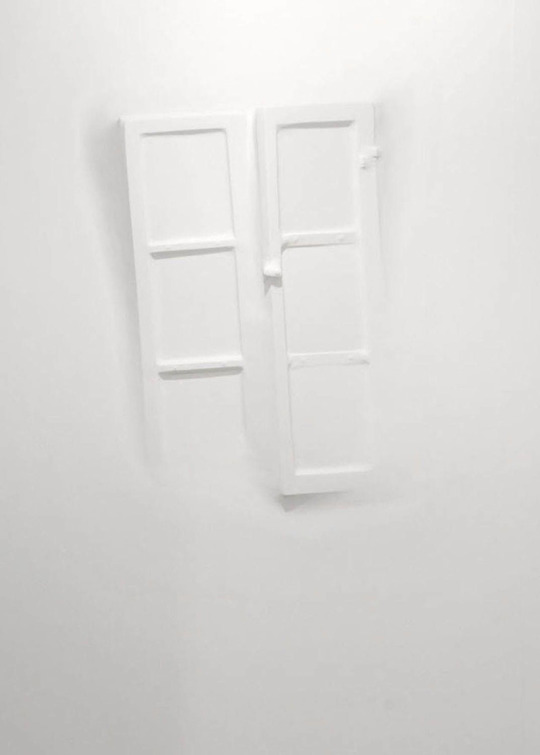
Another artist that caught my interest is David Altmejd, with his artwork 'Le Trou' (The Hand). I found this artwork when researching contemporary artworks involving hands as they have been of interest to me recently. This particular artwork struck me because of how something without any form of colour and relatively simple forms could express such powerful emotion. In further research, I found a number of his other works were also highly psychological and abject, and focussed on distorting the human form, but in logical and mathematical ways, sometimes described as 'crystalline' to highlight the ways that different perceptions of reality can overlap and merge.
Image on Left sourced from daltmejd on Instagram.
Other images: https://www.davidkordanskygallery.com/viewing-room/one-on-one-david-altmejd


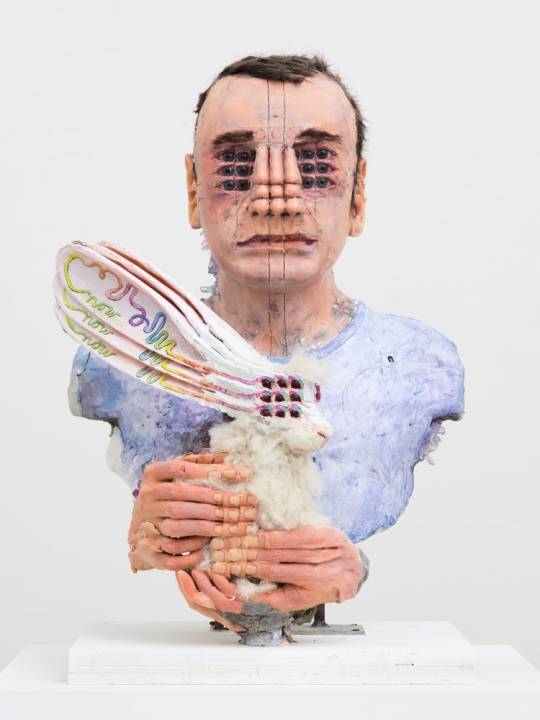
I don't want to make an excessively long post, so these are some other artists of interest I've looked into:
Susanna Bauer (the highly delicate and detailed embroidery works make powerful connections to the natural world), Armelle Blary Daphné (the stark red and white fabric sculptures convert the human body into dense structures of coral and roots), Wim Delvoye (the extremely detailed scultpures warp the world into a mathematical reality, drawing on contemporary and traditional art concepts), Keiko Sato (reminds me of exploring the ways that technology attempts to mimic the existing forms of the natural world), Jamie North (taking hard and industrial forms and placing them in organic shapes and softening them with plant inclusion), Marc Pouyet (using the natural world to create structural whimsy), Nicoletta De La Brown (Combining craft with contemporary waste in a performance that celebrates it rather than rejects it), Jonathan Callan (taking the readymade and converting it into something supple and new).
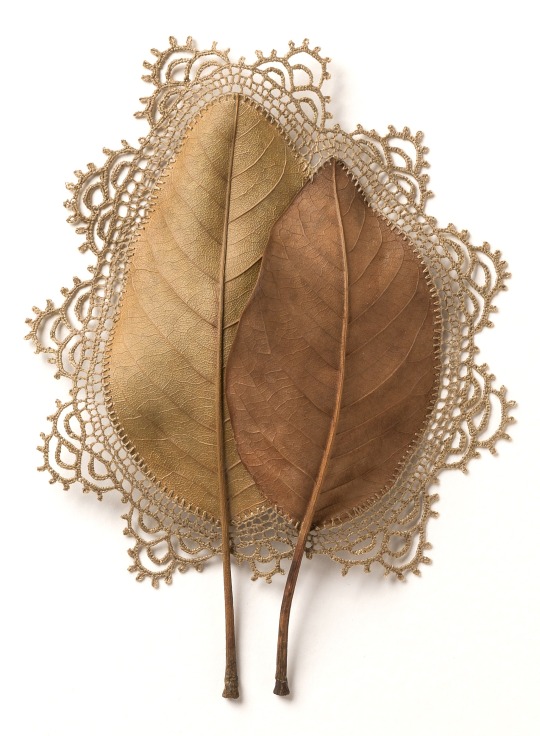
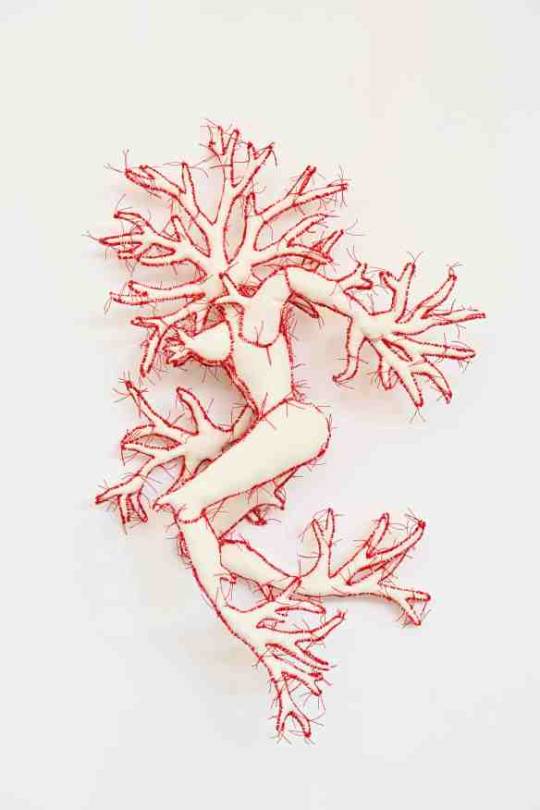





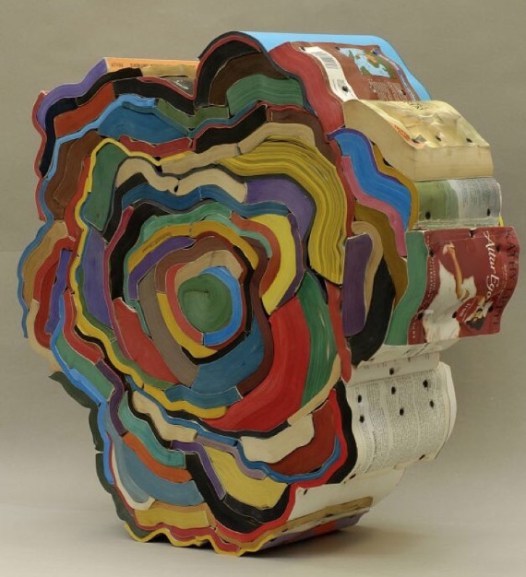
Image sources (in order) https://www.susannabauer.com/, https://armelleblary.com/sculptures-et-installations/, http://viemagazine.com/wim-delvoye-art-of-steel-and-elements/, http://kathrynrodrigues.blogspot.com/2011/02/metamorphosis-by-keiko-sato-laser-beam.html, https://www.behance.net/gallery/28139599/Rock-Melt-2015, https://www.designspiration.com/save/1845621598407/, https://www.mrxstitch.com/all-about-plastic-bags/, http://www.electricdreaming.com/archives/748
5 notes
·
View notes
Text
The group install was certainly something... It was really cool to see what tools exist to make installs happen like the tripod eye level marker. At first it was really hard to work out where to put things, because we had a couple of people who were very sure about what they wanted and where to put things, and those things didn't necessarily complement each other on their own. As we discussed though, we discovered that our works actually had quite strong conceptual links which just happened to align with our colour choices, so we were able to make something cohesive after all. I think if I was to do something like this again, I would want to have more time planning about the sizing of different works because we had a lot of big works outside, and then most of the inside works were quite small which left the space feeling a little bit incomplete. That could easily just be due to personal preference though.
We had a few hiccups along the way, but overall I would consider it successful, though with definite considerations for future improvements.



0 notes
Text
I was unsure about bringing my mushroom sculpture on campus for the group install because of how fragile it is. I was thinking about ways to protect it, and one thing that occurred to me is that I could potentially make a 3d model of it and use it. I researched accessible forms of photogrammetry, and I came across mobile phone photogrammetry apps. I tried Kiri Engine and Polycam. Kiri didn't give me as good a result, but I'm quite happy with the model and mesh produced by Polycam (shown in low quality in the video below).
I like the idea of experimenting more with reproduceable artworks, and I think this is a really interesting starting point. I would love to make an installation where a whole room is covered in a series of different mushroom sculptures, almost speaking to a society and a world built on the rot of past societies, but unfortunately even with the speed advantage of being able to digitally replicate models, my own material limitations prevent that from properly coming to fruition at the current point in time.
0 notes
Text
I decided to research more artists that use mushrooms to see different interpretations. One artist I found really interesting was Carsten Holler. Holler uses massive scale mushrooms, and displays them in strange ways, almost reminiscent of Wonderland. This becomes more apparent on further research, as Holler is actually a qualified biologist, and considers the biological implications of his work, especially with the interactions of viewers. Holler intentionally used fly agaric mushrooms in his installation, because when consumed they have poisonous and hallucinogenic results, and his installation creates the impression of a strange hallucination.

I also encountered another artist using hands, as I came across Bruce Nauman's series of hand sculptures in bronze. These sculptures further highlighted for me the ways that hands are so powerfully intrinsically related to human interaction and communication, and also how much the gestures of hands can express about a person or a group of people.

0 notes
Text
I decided I wanted to try combining hands with a non-human object in order to add in a new layer of affectual concept. Thinking about the ecological link people had made with my art, I started to consider plants that I could use. I considered making a fern, but I researched the symbolism of ferns and none of the options really stood out, so I decided to consider more options, though I may loop back to them later. I landed on mushrooms both for their aesthetic qualities and the dual nature of their symbolism as things of beauty and new life, yet also being things that only grow from death. I sculpted some mushroom bases, as well as a number of hands, and I started connecting the hands to the mushrooms in a similar manner to when I made my hand person. I noticed that I instinctually placed the hands face up, with the fingers relaxed and limp, and I realised they looked almost dead. I like how that combined with the desaturated beige of the base clay and the concept of mushrooms as a decomposer to make it seem as though the mushrooms are literally forming out of something dead.


Thinking about the way that the conglomeration of hands implies some kind of community (like in my hand person work, and in Xooang Choi's The Wings), I feel like it tells the story of a community that fell apart, and the new things that were able to grow out of that ending. I feel like it tells a story of hope on the other side of a breaking. It resonates a lot with my own experience losing relationships and finding new communities on the tails of those losses. It doesn't negate the loss, but it allows something new to come out of your life.



0 notes
Text
I decided to experiment with full gore. I started making it just for fun, but some stages of it I think are really quite effective.
When I was experimenting with different ways to build colour balance in the piece, I started by making the viscera into realistic colours, but then I turned the stained areas a bright blue. It reminds me of methylene blue, the substance that is used to dye samples on a microscope slide, giving it a clinical feeling. In my personal association, it seems like the scene is being examined either like a crime scene or like a medical sample.
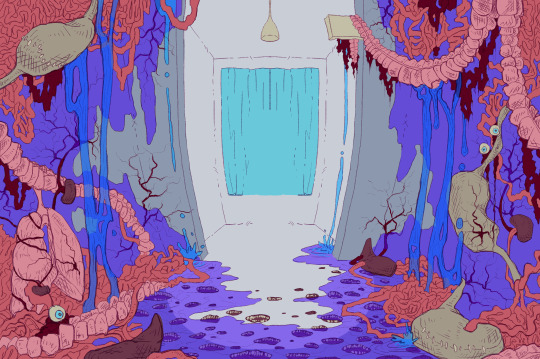
I took the piece on to a full texture render, and I love how macabre it looks. I like the way it represents a character without actually making a specific character. It has a cold, clinical room, and the character is standing on the threshold, either looking in to the clinical room, or looking out into the seemingly endless horror. It creates a tension as the viewer is made to question what might be so horrifying in the simple white stall that they would consider braving the gore outside, or whether they possibly have something to do with the horror to begin with. Because of how private internal organs are, it seems almost like the horror has come from the character or other people who the character personally knows.
In a way, I associate this with my own experience with people entrusting me with aspects of their life. I tend to take people's issues well, and I am good at staying solid under the pressure of their issues, so a lot of friends and people I care for choose to confide in me, and they sometimes do bare the rawest parts of themselves to me, but for some people there comes a time when they no longer see me as a person, but more as just an empty figure who they can share their secrets with - or maybe I just start to see them as their secrets rather than themselves. I sincerely hope that I will never forget to see the person behind the figure, though sometimes I find myself looking into people's faces, and feeling like I'm only looking at them for the first time. People are not just the perfect figure, nor are they just the broken mess. People are complex and layered and incredible and I don't think I could ever truly understand everything about humanity. I want to be in a place where I can see and love whatever sides people show me.
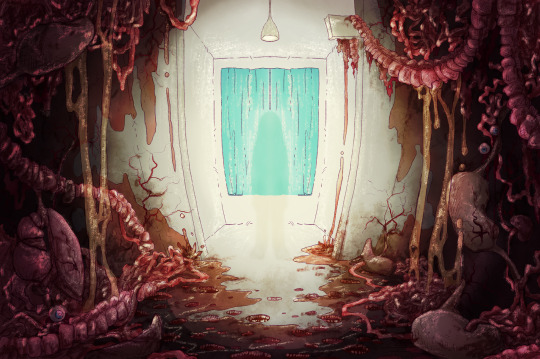
Comments from other people also connected the small room with change rooms, and personal insecurity around body image. I can see that interpretation too. I like that all people seem to connect it with the different faces and insecurities that people choose to show the world.
0 notes
Text
I wanted to experiment with other ways to represent similar concepts to my hand person sculpture. I was interested in experimenting with ways that one body part (in this case I stuck with hands) could try to become another part. I made hands, and then tried to form them to represent different body parts. I started with things like torsos and feet, but I found it was too similar to the hand person, so I tried again but with internal organs. I found that the hands made alright iterations of some, and plan to paint them so that they look more like the internal organs than the hands. That said, I may end up discarding this piece because I'm not really feeling it. Seems like a shallow reasoning but when I make art I don't want it to be utterly disingenuous, and generally forcing art just makes worse art all around.\

0 notes
Text
I found the in class presentation of my hand person artwork went fairly well, and I liked some of the points that people brought up in the discussion.
My artworks were fairly heavily associated with abject art in critiques, so I decided to research more what the abject art movement included. I saw a lot of connections between the artworks that I was inspired by and abject concepts. I read an article (https://www.artsy.net/article/artsy-editorial-contemporary-women-artists-obsessed-grotesque) on abject art which I think brought a lot of light to the concept for me, and it also showed me a lot of artists, some of which really resonated with me. I love Doreen Garner's work, and the way it casts horror in an almost stylised way but in a hyperrealistic context. I also like Jala Wahid's art as it takes a more plastic-y, tactile approach to abject imagery. I like the way that this art movement provides a place for people to experiment with and embrace uncouth or grotesque experimentations in art, and turns them into a thing that you need to look at, rather than something to avoid.


One of Doreen Garner's artworks is visible to the left, and Jala Wahid's to the right.
There were also questions about whether I ever want to go gorey with my artworks. My initial response to that was a definite no - I just hadn't ever really considered it, though I'm not so sure anymore. I might try to experiment a bit with it just to see what happens.
1 note
·
View note